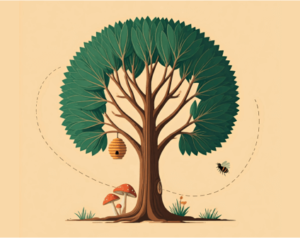In our quest for productivity, we often look to human-made tools, systems, and apps to optimize our work. However, some of the most profound productivity lessons are embedded in nature itself. From the social dynamics of bees and ants to the self-sustaining ecosystem of a forest, the natural world has evolved strategies for survival, efficiency, and growth over millions of years. Let’s look at what we can learn from these natural marvels and see how we can apply these principles to improve our productivity.
The Hive Mindset: Bees and Collaboration
Bees are the epitome of efficient teamwork. In a beehive, every bee has a specific role that contributes to the colony’s survival. Worker bees, drones, and the queen all function within a well-structured system. This division of labor allows them to maximize their collective output, ensuring that no one bee is overloaded.
Delegate Wisely and Define Roles Clearly
In task management, clearly defining roles and responsibilities is essential for productivity. When tasks are delegated effectively, it reduces duplication of work, distributes workload, and empowers each person to focus on what they’re best at.
Did You Know? Bees perform a “waggle dance” to communicate the location of resources. This unique behavior is a reminder that team communication should be clear and consistent.

The Ant’s Relentless Persistence: Small Steps Lead to Big Results
Ants are famous for their persistence and ability to tackle seemingly insurmountable tasks. Each ant carries tiny loads back to the colony, and while one ant’s contribution might seem insignificant, together, they build massive, intricate colonies that last for generations. Ants also follow each other’s scent trails, optimizing the route back to resources.
Break Down Big Goals into Manageable Steps
Productivity often falters when we become overwhelmed by the size of a task. Breaking down goals into small, manageable steps can keep us moving forward, just like ants moving one grain of sand at a time. Apps that allow us to create checklists, set micro-goals, and track progress, like the simple checkbox feature in Planndu, mirror the ants’ approach.
Interesting Angle: Ants optimize paths by following each other’s scent trails. For us, that’s like analyzing our routines to find smarter, more efficient paths, helping us work with purpose rather than just effort.

Trees and Ecosystems: The Power of Networking and Support Systems
Trees are not isolated beings; they form complex underground networks with fungi, known as mycorrhizal networks, often dubbed the “Wood Wide Web.” Through these connections, trees can share nutrients, warn each other about pests, and support weaker trees. This cooperative system allows forests to thrive.
Build a Supportive Network and Share Resources
In productivity, the lesson is clear: no one thrives in isolation. Building a strong network—within your organization, professional circles, or social groups—allows you to share resources, seek advice, and offer support.
Consider This: Trees communicate about threats and share resources to support each other. Applying this in your network by sharing knowledge or tools builds resilience and strengthens productivity for the entire group.

Seasonal Cycles: Knowing When to Work and When to Rest
Nature has a rhythm, with cycles of growth, dormancy, and renewal. Trees shed leaves in the fall to conserve energy for winter, animals hibernate, and flowers bloom in specific seasons. This cycle is essential for sustainability and health.
Respect Your Cycles of Productivity and Rest
In our fast-paced world, many people ignore the need for rest, pushing themselves to work continuously. But humans, like nature, have rhythms—periods of high energy and periods when we need to recharge. Recognizing and respecting these cycles is key to long-term productivity. Techniques like the Pomodoro method encourage working in focused bursts followed by breaks, much like natural cycles.
Food for Thought: Trees conserve resources by shedding leaves and entering dormancy. For us, taking a mental “detox” on weekends or setting boundaries can prevent burnout and sustain productivity.

Nature is nothing if not resilient. Forests regrow after wildfires, ecosystems adapt to new conditions, and species evolve over generations to thrive in changing environments. Nature’s resilience reminds us of the importance of adaptability in our productivity strategies. Plans can and do go wrong. Adapting to changes, learning from setbacks, and continuously improving our approach are critical productivity skills.
So, the next time you’re overwhelmed by a project or looking for ways to optimize your workflow, look to nature. You might just find that the most efficient, innovative solutions are already being practiced all around us. Just as nature thrives on synergy and adaptation, so too can we, when we adopt these timeless principles into our daily lives.




